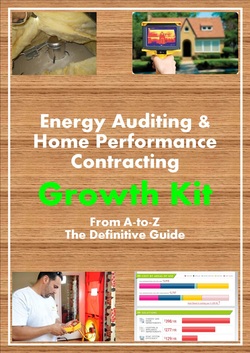Passing the BPI Exam With Energy Auditor Training
FREE BPI PRACTICE EXAMPUT YOUR HOME PERFORMANCE BUSINESS ON ROCKET FUELENERGY AUDITOR NEWSLETTERGet the only Energy Auditor Marketing Newsletter with monthly strategies and tactics to grow your home performance business.
|
BPI Written Exam - Section 2 Buildings and Their Systems
If the air handler is located in the crawlspace and the crawlspace has a dirt floor, then moisture buildup is a concern and sealing the crawl space is recommended along with a vapor barrier, dehumidifier and sump pump. Insulation should also be added to the crawlspace ceiling as well as air sealed to help warm the floors.
Basements should have insulation installed along the walls Look for common locations of air leaks in basements and crawlspaces:
Step 1. Seal any gaps or cracks in basement wall, ceiling or floor. It is best to seal up the top and bottom of the inside of the rim joist cavity. This is especially important at areas such as bay windows that hang off the foundation. Use caulk for any gaps or cracks ¼ inch or less and spray foam for anything larger. It is also very important to seal any holes for wires, pipes or other service areas that may lead to other floors of your home. Step 2. Cut insulation and insert accordingly. Insert and secure all insulation between holes in rim joists. If using batts, cut the insulation to fit and place against the rim joist. If using rigid foam insulation, foam around the edges to hold the insulation in place. After installing the rigid foam insulation or fitting batts into rim joists, seal any remaining holes and cracks to make your basement airtight. If crawlspaces are located in hot dry climates like Phoenix, crawlspaces do not need to be enclosed because the climate has little moisture build-up. The most important items would be to seal the ductwork and reduce the heat gain from sun struck windows. Basements Basements tend to retain moisture from the improper exterior drainage and interior moisture sources such as water heaters, heating and cooling systems and plumbing. Crawlspaces Depending on the climate, crawlspaces can also retain moisture in climates like San Francisco, Florida or the NW. In Phoenix, crawlspace moisture doesn't exist. Issues to be aware of are finding critters, spiders and rats (and their feces) much more frequently than in an attic. A 6 mil polyiso vapor retarder can be installed across the entire crawlspace to isolate it from moisture intrusion.
Sealing the crawlspace may not always be the best solution though. Venting the crawlspace is sometimes appropriate as in Arizona or a climate with little humidity. If you want to minimize moisture into crawlspaces, the stem walls and earth should be air sealed with a 6 mil poly vapor barrier. The 6 mil poly should be stapled down into the earth with a 6" turf stake every 6-8 feet and more frequent by the crawlspace entrance. The 6 mil poly should also sealed to the crawlspace stem wall. Source: Energy Star Next Section2a. Building Components
2b. Conservation Strategies
2c. Comprehensive Building Assessment Process
2d. Design considerations
|

